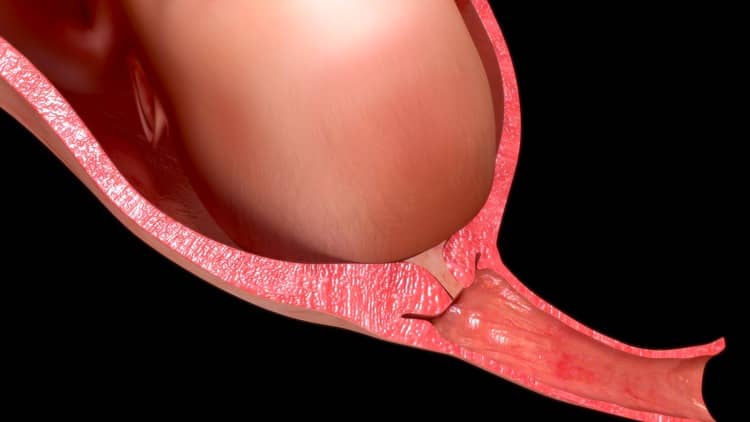
Mucus plug - what does it look like, does it go away even before childbirth?
Pregnancy is a period in which the woman and her own body become the only protector of the developing fetus. The child is located in a safe amniotic sac, while this is not the only safety box of the female body during pregnancy. The fetus is protected from infections by the so-called mucus plug located in the cervical area. The natural release of the mucus plug occurs when the cervix expands and the birth itself gradually begins.
What does a mucus plug look like during pregnancy, is it okay if a mucus plug with admixture of blood escapes from a pregnant woman's body, or, on the contrary, a mucus plug without blood, but we will clarify the process of the exit of a mucus plug in the following paragraphs of our article.
What is a mucus plug in pregnancy?
The mucous plug has the function of a kind of protector of the fetus against infectious threats during the entire pregnancy. It ensures that no harmful bacteria or infections reach the fetus, and that the cervix itself is not injured. A mucus plug is literally a plug that serves as a closure of the cervix and protection of the neck, uterus and developing fetus, while mucus is produced by the cervix during a woman's cycle. However, due to the rising level of progesterone, and therefore the pregnancy hormone, the mucus increases its density, and thus the mucus plug itself is formed.
Progesterone is a factor that not only helps in the initial stages of pregnancy immediately after fertilization, but is also a very important constant in maintaining pregnancy. Mucous plug, or its very release in the form of a thick discharge is a very important signal for pregnant women of impending birth, so it is convenient if they can identify the mucus plug.


What does a mucus plug look like?
Pregnancy is associated with many insecurities, fears and stressful situations, which is why it is possible to state that early recognition of a mucus plug is one of the leading rungs in the stress ladder. There are several vaginal secretions that can confuse a woman during the last trimester of pregnancy, including vaginal discharge, amniotic fluid and the aforementioned mucus plug. However, it is possible to find certain consistency and color differences between these three secretions, which will help you successfully differentiate whether it is a mucus plug or discharge.
While amniotic fluid is a much more voluminous and watery secretion in terms of consistency, vaginal discharge is more like egg white due to its sticky and opaque nature. But the mucus plug is thick like gelatin. From the color aspect, the mucus plug cannot be clearly characterized, as it is influenced by a number of factors. Can the mucus plug be white? Of course. In general, the mucus plug is white to translucent, but it can also be pinkish or gray-green.
The coloring due to the content of a little "old" blood can even change to more brownish or red. In this case, it should be noted that the low content of blood in the mucus discharge is normal, and therefore there is no need to be unnecessarily nervous about this aspect. A mucus plug is therefore a small concentration of mucus of a thicker consistency, while sometimes it may contain a little blood coming from the veins located on the cervix.

When does the mucus plug leave?
As we mentioned above, the expansion of the cervix due to the gradual descent of the uterus and the displacement of the fetal head into the pelvis goes hand in hand with the release of the mucus plug. This process inside the female organism means that the birth of a baby is a matter of the near future. Due to the signaling function of the mucus plug, many women may initially mistake it for amniotic fluid, but the departure of the mucus plug is only a sign that childbirth is approaching.
Every woman is different in how long it takes for their mucus plug to go away. While in some it is released in one unit, in other pregnant women it is gradually released in pieces, while it also happens that it is released at the same time as the amniotic fluid. Here too, the individuality of each case applies.
The pain factor of mucus plug release also varies from woman to woman. Pregnant women may or may not feel them when the mucus plug separates before childbirth. For some women, this process is completely painless, which ultimately leads to not noticing its progress at all, while others feel mild pains reminiscent of those experienced during menstruation. Especially in the lower back and lower abdomen. Mucous plug and pain are therefore not excluded at all.
However, the answer to a frequent question about the time gap between the elimination of the mucus plug and childbirth is uncertain. For some women, labor pains can start within a few hours, or immediately after the release of the mucus plug, while others experience the first pains only a few days later. It happens that a pregnant woman immediately begins to feel contractions, which means that in the next 24 hours the final stage of pregnancy will occur in the form of childbirth. At other times, the mucus plug can be released during pregnancy without contractions following, in which case the woman will have to wait a few more days before giving birth.

Warning signs related to mucus plug before delivery
As we have already said, it is natural if the mucus plug has a brownish-red color. This is due to a certain, mostly small blood content. However, if you detect an increased concentration of blood in the secreted discharge resembling menstrual blood, it is necessary to seek medical help immediately. It can be a potential separation of the placenta, which endangers not only the fetus, but also the mother herself.
It is equally urgent to see a doctor if the mucus plug is released earlier than the 38th week of pregnancy. Although the date when the mucus plug leaves the body of a pregnant woman cannot be precisely determined, premature release is a significant reason to alert and check the situation with your doctor.
If my mucus plug is gone, when will I give birth?
Even in this case, the women on the discussion forum did not disappoint and expressed their experiences with loosening the mucus plug. The diversity of cases is reflected in such discussion contributions by mothers. Experiences from the opposite sides of the spectrum were also found in terms of distinguishing the mucus plug from the amniotic fluid. While some discussants stated that these two discharges cannot be confused, others only registered a watery discharge on the linen, while they had no idea that it was a mucus plug.
The question of time is also one of the extremely individual variables in the matter of loosening the mucus plug and subsequent birth. While some discussants confirmed that their babies were born within hours of the mucus plug being expelled, other discussion posts spoke of a long-term process of expelling pieces of mucus, which almost lasted several weeks.
Most women agreed that it is safer to go to the maternity ward as soon as the mucus plug is gone, despite the fact that it should not be a labor yet. Regardless of whether the staff sends the mother back home or keeps her for observation, such a solution is, according to them, much safer. In pregnancy, it is always better to be examined by experts than to sit at home in uncertainty and wait for the worst possible scenario.
The most frequent questions - FAQ
Are you also interested in more information related to the topic of mucus plug in pregnancy? Can you think of other questions that were not answered in the text of the article or in the question and answer section ? Feel free to put them in the comments below the article. We will try to answer them as soon as possible.
Is it necessary to go to the maternity ward if my mucus plug is released?
Does every woman have a mucus plug during pregnancy?
Can the mucus plug be loosened during intimate intercourse?
How to prepare for the loosening of the mucus plug?
Am I at risk of infection when the mucus plug no longer protects me after loosening?
Pridať komentár





